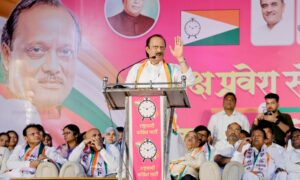
Amidst the pandemic, the Parliamentary Committee on Labour, submitted its report on the 23rd April, a week before the May Day. The Industrial Relations Code 2019, introduced in the Parliament had to be examined by ministerial standing committee, to the utter dislike of the government because of the issues raised by all the trade unions. Even Bharatiya Mazdoor Sangh, the trade union arm of the BJP had raised atleast a dozen negatives of the code.
The most stringent criticisms have come from the members of the committee itself. K.Subbarayan is a veteran left leader representing the labour intensive Tirupur constituency in Tamil Nadu, famous for its textiles. He has presented a dissent note calling out the objects and reasons themselves a sham. He calls it a “blatant lie of the government which takes away all the hard-earned rights of the crores of workers. He goes on to warn that this law “is ominous, insidious and pernicious for the democracy and people”.
Do these changes in the labour law regime warrant such a harsh statement or is it that the member belongs to the left and therefore is opposing the moves of the state?Developments over the years of this government and reports of the committees raise deep concerns.
Stealthy Beginning
The NDA Government started demonstrating its low priority of workers and their conditions just a month after its assumption of its first term in office in 2014 through an innocuous but far reaching notification . This proposed setting up a Central Analysis and Intelligence Unit and with stated objective of simplifying business regulations and bring in transparency and accountability in labour inspections, restricted the mandatory labour inspections i) The establishments where fatal or serious accident has occurred in last two years. ii) The establishments where strikes/lock out/retrenchment has taken place in two years. iii) Closed establishments till their workers’ dues are settled. As one can clearly see, the first two would have already been out in the open and media may have already covered the incident and inspection at that stage would in any case have lost its purpose of preventing such a situation. In the third, one wondered what would be the conditions of workers the inspectors inspect if the establishment was already closed? This virtually destroyed the already weak labour inspection system. Whatever little power and some fear that enterprises had was lost. This led to centralising the authority and reducing the scope of inspection even if there was information about an emerging situation as the “occupier” (as the owner is referred to in the Factories Act) has to be informed prior to inspection and the report written in the premises itself. Today the entire Inspectorate of Factories in every state is only waiting for the existing officials to retire.
Changing Laws to Codes
Soon after this big dent was made, the government announced as early as 2015, that it will amalgamate 44 pre-existing legislations into four codes on different issues of workers – Wage, Social Security, Occupational Health and Industrial Relations. When this announcement was made the then Labour Minister stated that though Labour was a concurrent subject “the States are on the same page as they all feel the need for a conducive atmosphere for development.” However, this amalgamation is still not complete. The Code on Wages, 2019 has been passed by both Houses of the Parliament and assented by the President in August 2019. The Code on Occupational Safety Health & Working Conditions, 2019 was introduced in July, which was also referred to the Standing Committee. The Committee submitted its report in February this year. The Code on Social Security, 2019 was introduced in the Lok Sabha in December and is also being examined by the Parliamentary Committee.
Ambiguity in Definition: Law Makers Themselves Perplexed
Who is a worker and who is an employee? The law makers themselves are themselves unsure. The Parliamentary Committee observes “terms ‘Employee’ and ‘Worker’ have been differentiated and defined separately on the logic that the dispute resolution mechanism under the Industrial Disputes Act, 1947 is available only for workers and persons engaged in certain administrative and managerial capacities beyond a prescribed wage ceiling are not getting the benefit of the dispute resolution mechanism. The Committee are not at all convinced with the argument for making an artificial differentiation between Employee and Worker. As a matter of fact, every employee is a worker and vice-versa. Therefore, the industrial dispute mechanism and other rights like forming of Trade Unions, being office bearers of the Trade Unions, etc. should be made available to each and every employee/worker, notwithstanding the relevant provisions contained in the Industrial Disputes Act which was enacted as early as 1947.
In their Report on ‘Occupational Safety, Health and Working Conditions Code,2019′ the Committee had pointed out that the unwarranted differentiation between ’employee’ and ‘worker’ had led to much perplexity and befuddlement and thus the Committee had asked the Ministry to use one uniform word everywhere. Since that has apparently not been done as yet, the Committee now recommend that wherever the two words have been referred to in this Code separately, only one term i.e. ’employee’ be used invariably. Alternatively, both the terms should co-exist everywhere viz. ’employee/worker’ or ’employee and worker’ so as to ensure that there is no discrimination in the applicability of labour laws to the employee/worker. This uniformity should be maintained in all the four Codes and the Committee are confident that once it is done, most of the undesirable litigation will cease to exist.”
Ominous Future?
The current pandemic has exposed the how close to the brink the workers are throughout the world. Lay-offs, cuts in wages and squeezing extra hours of work on one hand and the deplorable conditions of the migrant workers seem to be the current normal across the world. The desperation of the workers to go back to their villages clearly indicates that the current economic model has completely failed the worker. This has also laid bare the gross economic, social and spatial inequalities. This month the CMIE estimated a 23 percent hike in unemployment which was already at an all-time high. Workers seem to be the last in the priority of this Government.
If the laws are a sham and lawmakers themselves confused and owners making use of every opportunity to exploit one fears much worse is ahead for the workers. There are generic problems with the entire process of revamping the laws in the name of transparency and ease-of doing business. This need to be systematically examined and the government and employers made accountable to the lives of those who create wealth and pay taxes.
[the_ad id=’22723′]


















